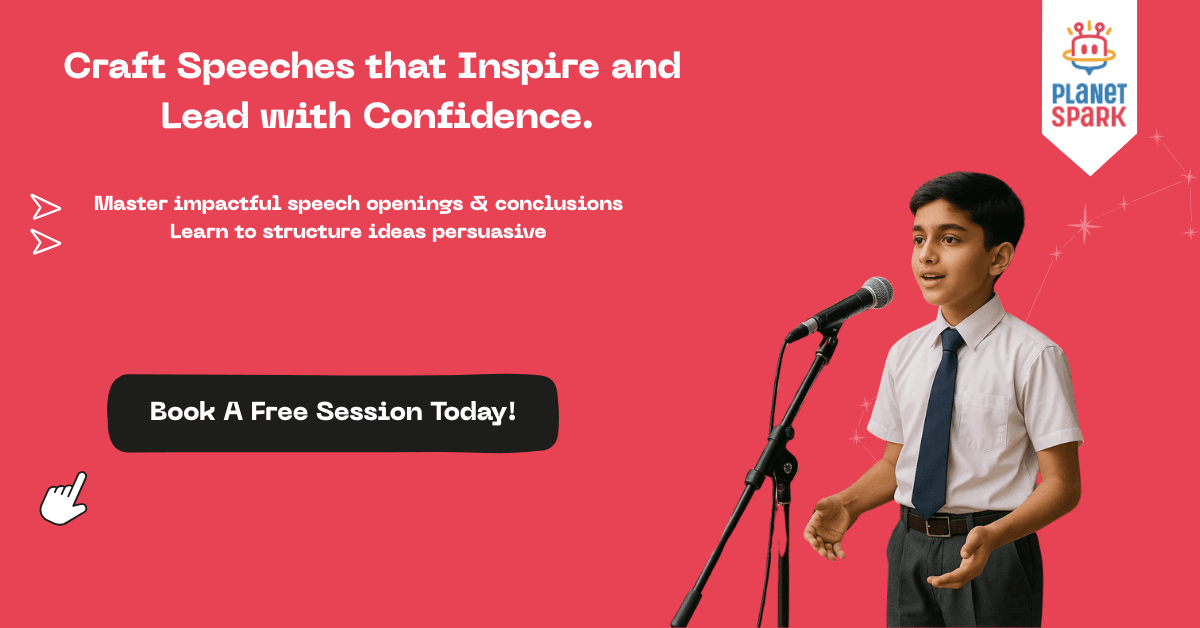Save Environment Speech for Students with Tips and Samples

Saving the environment is one of the most important responsibilities we share today. From clean air and fresh water to trees and animals, nature gives us everything we need to live and grow. For students, delivering a save environment speech is more than just a school activity, it’s a chance to create awareness and encourage others to act.
Whether it’s for an assembly, competition, or Earth Day event, children can make a big impact with the right words. At PlanetSpark, we support students in writing and delivering meaningful speeches with structure, clarity, and confidence.
In this blog, we’ve shared four sample speeches for different age groups to help your child speak up for the planet with purpose and passion.
Save the Environment Speech for Students
These sample speeches are designed to help students of all age groups speak confidently on the importance of protecting our planet. Each speech follows a clear structure and is timed to match school competitions, assemblies, and class presentations.
1-Minute Save Environment Speech
Good morning, my name is [Your Name].
Today, I want to talk about saving the environment.
The environment includes everything around us: air, water, trees, animals, and people. It gives us what we need to live. But our planet is in danger because of pollution, cutting down trees, and throwing garbage in the wrong places.
We all can help protect it. Plant more trees, use less plastic, save water, and keep your surroundings clean. These are simple steps we can all follow.
Even small actions can make a big difference if we all work together. Let us take care of our planet so that it stays beautiful and safe for everyone.
Thank you.

A thoughtful speaker becomes a thoughtful leader.
Give your child the skills to lead with words. Book a Free Demo Now!
2-Minute Save Environment Speech
Good morning everyone, my name is [Your Name], and I am here to speak about saving the environment.
The environment is our life support system. It provides us with clean air to breathe, fresh water to drink, food to eat, and a place to live. But today, our environment is in serious trouble. Pollution is rising, forests are being cut down, animals are losing their homes, and plastic waste is filling our rivers and oceans.
We must take action before it is too late. Small changes in our daily habits can make a big difference. We can stop using single-use plastic, switch off lights when not in use, and save water. Walking or cycling instead of using cars for short distances also helps reduce air pollution.
Planting more trees is one of the best things we can do. Trees clean the air and give shelter to birds and animals. Keeping our surroundings clean and spreading awareness in our schools and homes is also very important.
Saving the environment is not just the responsibility of adults or governments. As students, we too can play a big role. Together, we can protect nature and make sure our planet stays green and healthy for future generations.
Thank you.
3-Minute Save Environment Speech
Good morning, respected teachers and dear friends. My name is [Your Name], and today I want to share my thoughts on saving the environment.
The environment is everything that surrounds us. It includes the air we breathe, the water we drink, the trees, animals, and even the soil beneath our feet. It keeps us alive, healthy, and connected to nature. But in recent years, we have been harming the environment in many ways. We cut down trees for buildings, throw plastic into rivers, pollute the air with smoke from vehicles and factories, and waste resources without thinking about the future.
These actions are causing serious problems. The climate is changing. Summers are getting hotter, rains are becoming irregular, and natural disasters are more common than before. Animals are losing their homes, many are dying, and some species are even disappearing forever. Pollution is making people sick, especially children and the elderly.
But there is hope. We can save the environment if we all work together. We must stop wasting water and electricity. We should plant more trees, avoid using plastic bags, and recycle whatever we can. Walking, cycling, and using public transport can help reduce pollution. At school, we can run cleanliness drives, organise tree plantation programs, and talk to others about how to care for nature.
Even at home, simple changes like switching off fans when not in use or reusing old items can make a difference. We must also learn to respect every part of nature, whether it is a small plant or a large forest.
Let us become responsible citizens and protect the Earth for ourselves and for those who will come after us. Every action we take today will shape the world of tomorrow.
Thank you.
Shall I proceed with the 5-minute speech?
5-Minute Save Environment Speech
Good morning to everyone present here. My name is [Your Name], and I am here to speak about something that matters to all of us: saving the environment.
Our environment is the natural world around us. It includes the trees, rivers, oceans, animals, birds, and even the air we breathe. It gives us everything we need to live a healthy life. But sadly, our environment is being damaged every day. Forests are being cut down, air and water are being polluted, and animals are losing their homes. This is not just affecting nature but also harming our health and future.
One of the biggest threats is pollution. Smoke from vehicles and factories pollutes the air. Plastic waste fills rivers and oceans. Chemicals from farms enter the soil and water. These activities lead to problems like global warming, rising sea levels, and extreme weather. In many cities, the air has become so polluted that people struggle to breathe.
Another issue is the loss of biodiversity. When forests are destroyed, animals and birds lose their homes. Some species have already become extinct. Every creature plays a role in keeping nature balanced. When they disappear, the ecosystem suffers.
So, what can we do to help? Start small, but start now. Planting trees is one of the most effective ways to protect the environment. Trees clean the air and provide shade and shelter. We must reduce plastic use, recycle more, and save electricity and water. Simple actions like switching off lights and carrying reusable bags can make a big difference.
Schools and communities can organise clean-up drives and celebrate environment days. As students, we can become role models. Talk about these issues at home and in school. Encourage eco-friendly habits. Even writing and sharing a speech like this helps spread awareness.
Saving the environment is not a one-day job. It needs daily effort. We all share this planet, and it is our responsibility to take care of it. If we act today, we can still protect our future.
Let us work together to build a greener and safer world. Let us be the generation that acts with care and responsibility.
Thank you.

When kids speak from the heart, the world listens.
Guide your child to make meaningful speeches. Book a Free Demo Now!
How to Write a Save Environment Speech
Writing a strong speech about saving the environment is all about clarity, emotion, and action. Follow these simple steps to create an impactful speech:
1. Start with a strong opening
Begin with a greeting and a sentence that grabs attention. Use a fact, a question, or a short story to connect with the audience.
Example:
Did you know that every year, 8 million tons of plastic end up in our oceans?
2. Explain why the environment matters
Talk about how nature supports our lives, like clean air, fresh water, food, and shelter. Help listeners understand the deep connection between people and the environment.
3. Highlight the problems
Mention key issues like pollution, climate change, deforestation, and species loss. Use simple language, and focus on 2–3 main problems to avoid overwhelming your audience.
4. Suggest solutions
Share what people can do to help. Focus on actions children and families can take, such as:
- Planting trees
- Reducing plastic use
- Saving water and electricity
- Keeping surroundings clean
5. End with a call to action
Your conclusion should motivate listeners to take responsibility. Encourage small steps and daily habits that make a difference.
How Many Words Can You Speak in One Minute?
When writing a speech, it’s helpful to know how many words you can comfortably speak in a given time. This helps you plan your speech length and avoid rushing. On average, people speak 120 to 150 words per minute at a clear, moderate pace. Here's an approximate word count guide:
| Speaking Time | Average Word Count |
|---|---|
| 1 Minute | 120 – 150 words |
| 2 Minutes | 240 – 300 words |
| 3 Minutes | 360 – 450 words |
| 4 Minutes | 480 – 600 words |
| 5 Minutes | 600 – 750 words |
Tip: Practice reading your speech aloud with a timer to make sure it fits your time limit comfortably.
Tips to Deliver an Impressive Save Environment Speech
Writing a great speech is only half the job. Delivering it with confidence, clarity, and energy makes all the difference. Here are a few tips to help students shine on stage:
1. Use positive body language
Stand straight, make eye contact, and use natural hand movements to look confident. Positive body language helps the audience trust and connect with you.
Learn more here: Positive Body Language for Kids
2. Practice often
Rehearse your speech several times at home. Practice in front of a mirror or with family members to build fluency and reduce nervousness.
3. Speak clearly and slowly
Take your time with each sentence. Speaking too fast can make it hard for people to understand your message. Pause after key points to let your words sink in.
4. Build stage confidence
Get comfortable with being on stage by participating in school assemblies or group discussions.
Need help? Read this guide: How to Develop Confidence in Public Speaking for Kids
5. Know your content well
Understand your topic so you don’t rely only on memorisation. If you forget a line, you can continue speaking naturally.
Public speaking is the bridge between thought and impact. Help your child cross it with confidence.
Book a Free Demo Now!
Challenges Kids Face While Delivering a Speech
Every child has the potential to speak confidently, but a few common challenges may hold them back. Here's a quick overview:
| Challenge | What It Means | Tip to Overcome |
|---|---|---|
| Stage fear | Feeling nervous or scared in front of an audience | Start small with home practice and gradually increase the audience size |
| Forgetting lines | Losing track of the speech midway | Encourage understanding over memorising; use keyword cards |
| Speaking too fast or too slow | Rushing through or dragging the speech | Practice with a timer to find a steady, natural pace |
| Lack of confidence | Feeling unsure or hesitant while speaking | Boost confidence through positive feedback and small wins |
| Poor body language | Slouching, avoiding eye contact, or fidgeting | Teach basic body language skills through fun mirror exercises |
Helping children work through these challenges not only improves their speech but also builds lifelong communication skills.

How PlanetSpark Helps Kids Speak with Confidence
PlanetSpark helps children become strong communicators through structured learning and fun engagement. Here's how we support your child's public speaking journey:
- Expert-led sessions that build clarity, fluency, and expression
- Interactive activities to practise real-life speaking situations
- Body language training to improve posture, eye contact, and gestures
- Personalised feedback to address individual strengths and areas of growth
- Stage exposure opportunities through online competitions and showcases
- Confidence-building modules to overcome fear and speak freely
At every step, we help your child find their voice and speak with impact.
Conclusion
Encouraging kids to speak on important topics like organ donation nurtures empathy, awareness, and confidence. Whether it's a one-minute thought or a five-minute speech, giving children the platform to express themselves builds valuable life skills early on.
With the right support, regular practice, and engaging tools, your child can learn to speak with clarity and conviction. Keep guiding, keep encouraging and let their voice make a difference.
FAQs
1. What is the right age for a child to speak about organ donation?
Children aged 8 and above can understand the basic concept of organ donation. It's best to introduce the topic with simple, age-appropriate explanations.
2. How do I help my child prepare for an organ donor speech?
Start with a short, meaningful script. Encourage your child to practise aloud, work on pronunciation, and use gestures to express key points.
3. What should kids include in an organ donor speech?
A good speech includes what organ donation means, why it matters, and how it helps others. Real-life examples and short stories make it more relatable.
4. How long should a child’s speech on organ donation be?
It depends on the setting. One to three minutes is ideal for younger children, while older kids can confidently speak for up to five minutes.
5. Can PlanetSpark help my child with speech preparation?
Yes. PlanetSpark offers structured public speaking programs that teach kids to write, practise, and deliver impactful speeches with confidence.
Personalized Communication Report
Record a video to get a AI generated personalized communication report for your child

Hi There, want to try these
tips for your child with
LIVE with our expert coach?
Let's check your child's
English fluency